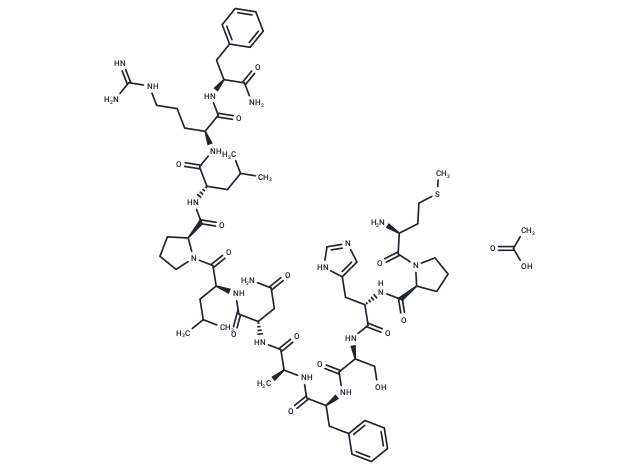Shopping Cart
- Remove All
 Your shopping cart is currently empty
Your shopping cart is currently empty

RFRP-1 (human) acetate is a potent endogenous NPFF receptor agonist (EC50 values are 0.0011 and 29 nM for NPFF2 and NPFF1, respectively). Attenuates contractile function of isolated rat and rabbit cardiac myocytes. Reduces heart rate, stroke volume, ejection fraction and cardiac output, and increases plasma prolactin levels in rats. GnIH homolog.

| Pack Size | Price | Availability | Quantity |
|---|---|---|---|
| 1 mg | $133 | In Stock | |
| 5 mg | $302 | In Stock | |
| 10 mg | $453 | In Stock | |
| 25 mg | $748 | In Stock | |
| 50 mg | $1,050 | In Stock | |
| 100 mg | $1,420 | In Stock |
| Description | RFRP-1 (human) acetate is a potent endogenous NPFF receptor agonist (EC50 values are 0.0011 and 29 nM for NPFF2 and NPFF1, respectively). Attenuates contractile function of isolated rat and rabbit cardiac myocytes. Reduces heart rate, stroke volume, eject |
| Targets&IC50 | NPFF2:0.0011 nM, NPFF1:29 nM |
| Molecular Weight | 1488.77 |
| Formula | C69H105N19O16S |
| Smiles | NC([C@H](CC1=CC=CC=C1)NC([C@H](CCCNC(N)=N)NC([C@H](CC(C)C)NC([C@H]2N(CCC2)C([C@H](CC(C)C)NC([C@H](CC(N)=O)NC([C@H](C)NC([C@@H](NC([C@H](CO)NC([C@H](CC3=CN=CN3)NC([C@H]4N(CCC4)C([C@@H](N)CCSC)=O)=O)=O)=O)CC5=CC=CC=C5)=O)=O)=O)=O)=O)=O)=O)=O.CC(O)=O |
| Relative Density. | no data available |
| Storage | keep away from moisture | Powder: -20°C for 3 years | In solvent: -80°C for 1 year | Shipping with blue ice. | ||||||||||||||||||||
| Solubility Information | DMSO: 10 mM, Sonication is recommended. | ||||||||||||||||||||
Solution Preparation Table | |||||||||||||||||||||
DMSO
| |||||||||||||||||||||

Copyright © 2015-2025 TargetMol Chemicals Inc. All Rights Reserved.